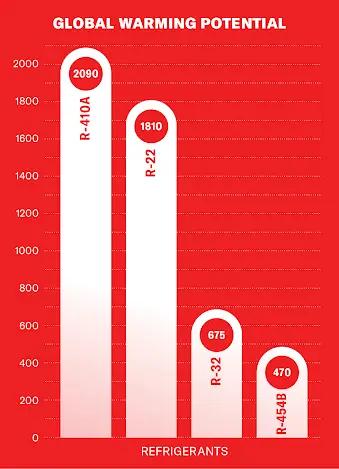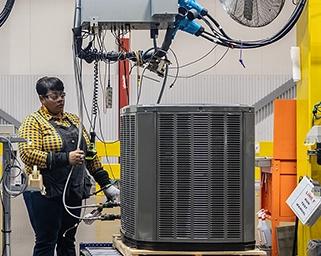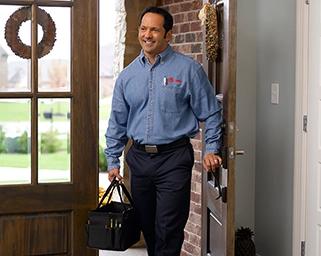A Complete Guide to HVAC Refrigerants
HVAC refrigerants are the lifeblood of your air conditioning system. AC units and heat pumps alike use a refrigerant. Big changes are coming in the HVAC industry regarding which refrigerants to use in newly manufactured products. We’ve put together this guide to help homeowners understand HVAC refrigerant history and refrigerants of the future.
By Anne Fonda
In this article, we will answer some of the most frequently asked questions about HVAC refrigerants, including:
- What is a refrigerant?
- What is global warming impact?
- What is R-22?
- What is R-410A?
- Is R-410A being phased out?
- What is the new refrigerant for HVAC in 2024?
- Do I have to replace my air conditioner that uses an old refrigerant?
Ready to learn more about refrigerants and get answers to your questions? Keep reading.
What is a refrigerant?
An HVAC refrigerant, or AC refrigerant, is a liquid or gaseous cooling compound that helps your air conditioner or heat pump cool your home in the warmer months. During the refrigeration cycle, refrigerants absorb and transfer heat to the outside.
There are many other refrigerants used in car air conditioning, home refrigerators, and commercial applications. For this guide, we will focus on HVAC refrigerants exclusively.
Why are we putting together a refrigerant guide now? Because there is a big transition going on in the HVAC industry, and it affects you, as a homeowner. We hope that by providing some information and answering common questions, you will understand the importance of refrigerants and how they affect not only your comfort but also the health of our planet.
What is global warming potential?
Global warming potential (GWP) is the potential a refrigerant (and other greenhouse gases) has to absorb and trap the sun’s heat in the Earth’s atmosphere. A refrigerant’s GWP is determined by comparing its global warming impact relative to the amount of carbon dioxide that would cause an equivalent global warming impact. The higher the GWP, the greater the climate impact.
The GWP of various refrigerants is in the news because of new regulations limiting their use based on their global warming potential.
What are the AC refrigerant types?
There are several common types of refrigerants used in residential AC applications. One has already been phased out, one is currently being phased out, and the other two are the newer air conditioner refrigerants that the HVAC industry is transitioning to for residential products.
R-22 (Freon™)
R-22 refrigerant, also known by the brand name Freon, is still in use in some older air conditioners and heat pumps manufactured before 2010. It’s a hydrochlorofluorocarbon (HCFC) which is a chemical that is mainly used as a refrigerant. When released into the atmosphere, HCFCs deplete the Earth’s protective ozone layer and contribute to climate change.
Why is R-22 banned from new production?
The United States committed to an international effort to regulate and phase out ozone-depleting substances with a high GWP such as R-22 when it joined countries worldwide to ratify the Montreal Protocol on Substances that Deplete the Ozone Layer. In 2010, the U.S. ceased new production and importation of R-22 except for servicing existing units.
Is R-22 still available?
Yes and no. R-22 is no longer being produced or imported into the United States for any reason. That final ban went into effect in 2020. However, due to recycling and refrigerant recovery from decommissioned AC units, R-22 is still available in limited quantities.
That means if you have an older air conditioner that uses R-22, you can still get it serviced and recharge the refrigerant. But if you need a new central air conditioner, it will use a newer refrigerant. Read more about the phase-out and what it means for you.
R-410A
R-410A is the R-22 refrigerant replacement that the HVAC industry transitioned to in AC units and heat pumps manufactured in 2010 and later. It’s a blend of hydrofluorocarbon (HFC) compounds R-32 and R-125.
Is R-410A being phased out?
Yes. Much like R-22 was phased out, R-410A is being phased out, for the same reasons - there are newer, more sustainable alternatives. In the 2020 American Innovation & Manufacturing (AIM) Act, the Environmental Protection Agency (EPA) gained the authority to set stringent standards for HFC use.
In September 2021, the EPA released a detailed plan to drastically reduce HFC consumption in a phased-in approach. Beginning in 2025, the plan prohibits using R-410A refrigerant in newly manufactured HVAC equipment.
How long will R-410A refrigerant be available?
R-410A will be available for years to come, and there will also be a supply of recovered R-410A as people replace aging AC units. In addition, HVAC manufacturers will have an inventory of heat pumps and air conditioners that use this refrigerant which they can continue to sell until inventory is depleted.
What refrigerant will replace R-410A?
After countless hours of research, most HVAC manufacturers, including Trane, have agreed that the best replacement is a refrigerant called R-454B. It will be phased in for newly manufactured HVAC cooling equipment such as air conditioners and heat pumps.
R-454B
R-454B is the newest refrigerant, which will gradually replace R-410A, the refrigerant used in HVAC manufacturing from 2010 until the phase-out is complete in January 2025. R-454B is a blend of R-32, a hydrofluorocarbon (HFC), and R-1234yf a hydrofluoroolefin (HFO). This blend enables maximum energy efficiency and performance while also reducing the potential for environmental impact.
Can R-454B be retrofitted into systems using R-410A?
No. R-454B is not compatible with older systems. That’s why the EPA is phasing out manufacturing units using R-410A but is still allowing it to be used in existing systems.
R-32
While R-32 is a component of R-454B, it is also a single-component refrigerant. R-32 has a good performance record in terms of heat transfer and pressure drop. It has been in use in China, Japan, and India for years.
Is R-32 a good refrigerant?
As stated, R-32 has a good performance record in heat transfer, the main job of a refrigerant. It is also good in terms of environmental impact. More on that, next.
Environmental impact of HVAC refrigerants

Refrigerants with a higher GWP negatively impact the ozone layer and are one of the many drivers of climate change. That’s why both R-22 and R-410A are being phased out. Compare the GWP of the various refrigerants in the graph above, and you’ll see newer refrigerants are much more sustainable. In addition to being low GWP refrigerants, R-32 and R-454B have 0 ozone depletion potential (ODP).
Trane and the refrigerant transition
Trane, in alignment with global environmental goals and new federal regulations, is committed to transitioning to low global warming potential (GWP) refrigerants in HVAC products by 2025.
Trane’s refrigerant selections go beyond regulatory compliance, aiming for a greener future by introducing heat pumps, air conditioners, and additional products with 78% less global warming potential.
We’re adopting the R-454B refrigerant for use in newly manufactured residential cooling products. R-454B has already demonstrated exceptional performance during Trane’s field trials in the U.S. Department of Energy’s (DOE) Cold Climate Heat Pump Challenge.
We’ll use a phased-in approach and will introduce new products using the R-454B refrigerant starting in 2024. Learn more about our commitment to sustainability and the refrigerant transition.
Proper handling and maintenance of HVAC refrigerants
As a homeowner, you should never handle HVAC refrigerants. That is something your HVAC technician will do when needed. This can include fixing a refrigerant leak or recharging (refilling) your refrigerant as needed. They are also trained in the proper disposal and recycling methods for used HVAC refrigerants repair.
Do I need AC repair or replacement?
If you have an older central air conditioning system that uses R-22 (manufactured in 2009 or earlier), the unit is nearing the end of its lifespan. While you can spend money on repairs and recharging the refrigerant, you may want to consider replacing the unit sooner rather than later.
If you have an air conditioner or heat pump that uses R-410A refrigerant and is approaching 15 years in service, you may also want to start considering air conditioner replacement or heat pump replacement. But if it’s only a few years old and running efficiently and you’re keeping up with HVAC maintenance, you can probably deal with smaller repairs as they come up for years to come.
Check out our Repair or Replace Guide for more information.
Get expert advice and HVAC product recommendations
Do you need AC repair? Are you considering an air conditioner replacement? Maybe you’re interested in a heat pump system. Whatever your HVAC needs, you can trust your local Trane Comfort Specialist to provide solutions and recommendations tailored to your home.
Anne Fonda
Content Writer, Trane Technologies
A Content Writer with Trane Technologies, Anne Fonda researches topics and writes for Trane® and associated residential HVAC brands. She works in collaboration with Trane Technologies subject matter experts, offering easy-to-understand, informative content on complex topics. Her goal is to help consumers make informed decisions on the products and services they need.
She has written for HVAC and other service provider websites for over 16 years. Before transitioning to web content writing, Anne had a 14-year stint as an award-winning journalist. She graduated cum laude from the University of Missouri-Columbia School of Journalism.
When she’s not working, Anne enjoys playing word games, reading, gardening, spending time with family, and visiting gardens and museums.
Expert review by Jeff Stewart, Refrigeration Chief Engineer




